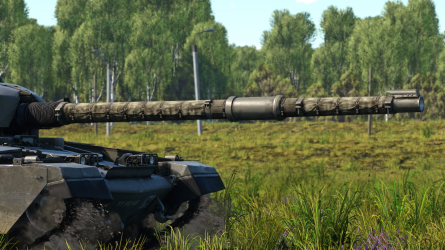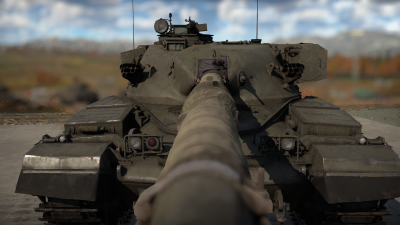Ordnance BL Tk. L11A5 (120 mm)
Contents
Description
The Ordnance BL Tk. L11 is a British 120 mm rifled cannon derived from the Conqueror's L1A2 120 mm main gun. This powerful gun was meant to be used in the Chieftain series Main Battle Tank, in-game this cannon is present on the Mk 3, Mk 5 and Mk 10 variants of this vehicle. At time of production, the L11, firing armour-piercing discarding sabot rounds (APDS), was one of the most fearsome anti-tank solutions present in an Armoured Fighting Vehicle and thus, fulfilled its purpose to defeat the 60s Soviet armour.
Vehicles equipped with this weapon
General info
Tell us about the tactical and technical characteristics of the cannon or machine gun.
Available ammunition
| Penetration statistics | |||||||
|---|---|---|---|---|---|---|---|
| Ammunition | Type of warhead |
Penetration @ 0° Angle of Attack (mm) | |||||
| 10 m | 100 m | 500 m | 1,000 m | 1,500 m | 2,000 m | ||
| Shot L15A3 | APDS | 298 | 296 | 288 | 277 | 268 | 258 |
| Shell L31A7 | HESH | 152 | 152 | 152 | 152 | 152 | 152 |
| Shot L23 | APFSDS | 410 | 408 | 405 | 400 | 390 | 380 |
| Shell details | ||||||||||||
|---|---|---|---|---|---|---|---|---|---|---|---|---|
| Ammunition | Type of warhead |
Velocity (m/s) |
Projectile mass (kg) |
Fuse delay (m) |
Fuse sensitivity (mm) |
Explosive mass (TNT equivalent) (kg) |
Ricochet | |||||
| 0% | 50% | 100% | ||||||||||
| Shot L15A3 | APDS | 1,372 | 7.48 | - | - | - | 75° | 78° | 80° | |||
| Shell L31A7 | HESH | 670 | 17.34 | 0.1 | 4 | 6.53 | 73° | 77° | 80° | |||
| Shot L23 | APFSDS | 1,535 | 3.89 | - | - | - | 78° | 80° | 81° | |||
| Smoke shell characteristics | ||||||
|---|---|---|---|---|---|---|
| Ammunition | Velocity (m/s) |
Projectile mass (kg) |
Screen radius (m) |
Screen deploy time (s) |
Screen hold time (s) |
Explosive mass (TNT equivalent) (g) |
| L34 | 670 | 17.1 | 20 | 5 | 25 | 50 |
Comparison with analogues
Give a comparative description of cannons/machine guns that have firepower equal to this weapon.
Usage in battles
Describe the cannon/machine gun in the game - its distinctive features, tactics of usage against notable opponents. Please don't write a "guide" - do not impose a single point of view, but give the reader food for thought.
Pros and cons
Pros:
- The APDS round has high penetrating power, able to defeat all but the most heavily armoured MBTs it encounters.
- Has access to HESH ammunition, being capable of overpressuring and destroying lightly armoured vehicles in a single shot.
- The L21A1 12.7 mm Heavy Machine Gun can be used alongside with the main gun to accurately rangefind targets for the HESH due to the similar ballistic performance of both rounds.
- Late vehicles (namely the Chieftain Mk 10) have access to APFSDS ammunition
Cons:
- Slightly less accurate than smoothbore counterparts
- HESH shells produce little spalling, making them impracticable to fight heavy vehicles
History
During the development stage of the main armament of the future FV4201 Main Battle Tank, several novel propellant systems were considered. One of those was most notably a liquid propellant compound which would have allowed the crew to vary the propellant amount for each shot and thus the ballistics of the projectile. However, this system was quickly found to be unfeasible after trials in 1953, and thus a bag-charge system became the favoured method. A 105mm gun using bag-charges was specified in 1954. At this time, the turret design of FV4201 allowed a limited amount of space, leading engineers to limit the length of ammunition components to 27 inches (68,58cm) as the maximum. This ruled out conventional one-piece ammunition such as usually found on contemporary tank guns like the 20pdr OQF Mk.I (84 mm) or the Soviet D-10T (100 mm). Separate bag-charge ammunition was chosen, dividing the ammunition up into three pieces: Projectile, Bagged propellant charge, and ignition primer in the form of a small magazine containing essentially blank rifle caliber rounds to ignite the propellant. From Chieftain to Challenger 2, this system was retained. Curiously, an attempt was made to achieve a proper seal in the gun breech using brass stub cases (as later used on the Rh120 L/44 (120 mm) and its US American derivative, the M256m which are ejected after every shot automatically as the rest of the casing is combustible. However, this could not be made reliable or safe at the time. The British solution designed 100% of the propellant charge to be combustible, so that as soon as the breech opens, a new shell can be loaded. It was claimed that this system reduces loader fatigue, as each individual component the loader has to handle weighs much less than the equivalent one-piece 105mm round.
The 120mm calibre was not set in stone from the start either. Twelve guns in calibres between 105 and 130mm were considered before 120mm was recommended for further development in December of 1955. This experimental gun, designated as 120mm X23E2/3 was estimated to be able to defeat 120mm of RHA at 60° at 2000 yards (The same layout as the glacis plate of the T-54 Mod. 1947 and 20mm thicker than on subsequent variants of the T-54 and T-55, all of which was yet unknown to the British before a T-54 could be gathered after the Hungarian uprisings in 1956). Using the HESH round, about 150mm of RHA could be defeated at any combat range. By comparison, the NATO standard 105mm L7 derivative guns used on Leopard 1 and M60 could only defeat the NATO standard medium target ( a T-54) at 1.250 yards, and could not reliably defeat the NATO standard heavy target ( a T-10) at any range.
The design of the X23 which in service became the L11 offers a fascinating insight into tank design procedures: It was found that most loaders were right handed and preferred to load using their dominant arm. This meant they are best positioned on the left of the turret so gunner and commander would have to be on the right. This in turn meant that the sights would be offset to the right of the barrel's bore, and therefore the rifling of the barrel had to have a clockwise twist in order to compensate. A mechanised ramming system was also experimented with, however it was unreliable and added even more weight to an already dangerously overweight vehicle. British Army loaders therefore resorted to "charge-ramming", using the bagged propellant charge to push the projectile all the way into the breech. Gunnery trials in July of 1962 impressed: At targets out to 2000m, the crews managed an 81% first round hit probability using APDS, proving the L11's accuracy. [1]
Media
- Images
See also
Links to the articles on the War Thunder Wiki that you think will be useful for the reader, for example:
- reference to the article about the variant of the cannon/machine gun;
- references to approximate analogues by other nations and research trees.
External links
References:
- ↑ Taylor, Dick. Chieftain, Main Battle Tank, Owners' Workshop Manual 1966 to present. Haynes Publishing Inc., 2016
| Britain tank cannons | |
|---|---|
| 30 mm | L21A1 |
| 40 mm | QF 2-pounder |
| 47 mm | Ordnance QF 3-pounder |
| 57 mm | 6pdr OQF Mk.III · 6pdr OQF Mk.V |
| 75 mm | OQF Mk.V |
| 76 mm | OQF 3-inch Howitzer Mk I · OQF 3in 20cwt · QF 17-pounder |
| 77 mm | OQF Mk.II |
| 84 mm | 20pdr OQF Mk.I |
| 94 mm | 28pdr OQF · 32pdr OQF · OQF Mk.II |
| 95 mm | Howitzer, Tank No.1, Mk.I |
| 105 mm | LRF · Royal Ordnance L7A1 |
| 120 mm | Ordnance QF Tk. L1A2 · Ordnance BL Tk. L11 · L11A5 · L30A1 |
| 165 mm | ORD BL 6.5in L9A1 |
| 183 mm | QF L4A1 |
| Foreign: | |
| 25 mm | M242 (USA) |
| 37 mm | M5 (USA) · M6 (USA) |
| 75 mm | M2 (USA) · M3 (USA) |
| 84 mm | kan Strv 81 (Sweden) |
| 105 mm | Sharir (Israel) |
| 120 mm | Rh120 L/55 A1 (Germany) |
| 125 mm | 2A46M-5 (Russia) |
| 155 mm | M185 (USA) |
| South Africa | |
| 20 mm | GI-2 |
| 76 mm | GT-4 |
| 90 mm | GT-2 |
| 105 mm | GT-3 · GT-7 · GT-8 |
| 155 mm | G6 L/45 |





